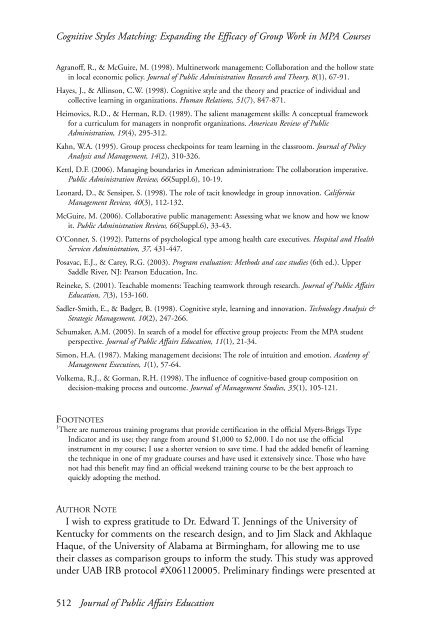JOURNAL OF PUBLIC AFFAIRS EDUCATION - National ...
JOURNAL OF PUBLIC AFFAIRS EDUCATION - National ...
JOURNAL OF PUBLIC AFFAIRS EDUCATION - National ...
Create successful ePaper yourself
Turn your PDF publications into a flip-book with our unique Google optimized e-Paper software.
Cognitive Styles Matching: Expanding the Efficacy of Group Work in MPA Courses<br />
Agranoff, R., & McGuire, M. (1998). Multinetwork management: Collaboration and the hollow state<br />
in local economic policy. Journal of Public Administration Research and Theory, 8(1), 67-91.<br />
Hayes, J., & Allinson, C.W. (1998). Cognitive style and the theory and practice of individual and<br />
collective learning in organizations. Human Relations, 51(7), 847-871.<br />
Heimovics, R.D., & Herman, R.D. (1989). The salient management skills: A conceptual framework<br />
for a curriculum for managers in nonprofit organizations. American Review of Public<br />
Administration, 19(4), 295-312.<br />
Kahn, W.A. (1995). Group process checkpoints for team learning in the classroom. Journal of Policy<br />
Analysis and Management, 14(2), 310-326.<br />
Kettl, D.F. (2006). Managing boundaries in American administration: The collaboration imperative.<br />
Public Administration Review, 66(Suppl.6), 10-19.<br />
Leonard, D., & Sensiper, S. (1998). The role of tacit knowledge in group innovation. California<br />
Management Review, 40(3), 112-132.<br />
McGuire, M. (2006). Collaborative public management: Assessing what we know and how we know<br />
it. Public Administration Review, 66(Suppl.6), 33-43.<br />
O’Conner, S. (1992). Patterns of psychological type among health care executives. Hospital and Health<br />
Services Administration, 37, 431-447.<br />
Posavac, E.J., & Carey, R.G. (2003). Program evaluation: Methods and case studies (6th ed.). Upper<br />
Saddle River, NJ: Pearson Education, Inc.<br />
Reineke, S. (2001). Teachable moments: Teaching teamwork through research. Journal of Public Affairs<br />
Education, 7(3), 153-160.<br />
Sadler-Smith, E., & Badger, B. (1998). Cognitive style, learning and innovation. Technology Analysis &<br />
Strategic Management, 10(2), 247-266.<br />
Schumaker, A.M. (2005). In search of a model for effective group projects: From the MPA student<br />
perspective. Journal of Public Affairs Education, 11(1), 21-34.<br />
Simon, H.A. (1987). Making management decisions: The role of intuition and emotion. Academy of<br />
Management Executives, 1(1), 57-64.<br />
Volkema, R.J., & Gorman, R.H. (1998). The influence of cognitive-based group composition on<br />
decision-making process and outcome. Journal of Management Studies, 35(1), 105-121.<br />
FOOTNOTES<br />
1 There are numerous training programs that provide certification in the official Myers-Briggs Type<br />
Indicator and its use; they range from around $1,000 to $2,000. I do not use the official<br />
instrument in my course; I use a shorter version to save time. I had the added benefit of learning<br />
the technique in one of my graduate courses and have used it extensively since. Those who have<br />
not had this benefit may find an official weekend training course to be the best approach to<br />
quickly adopting the method.<br />
AUTHOR NOTE<br />
I wish to express gratitude to Dr. Edward T. Jennings of the University of<br />
Kentucky for comments on the research design, and to Jim Slack and Akhlaque<br />
Haque, of the University of Alabama at Birmingham, for allowing me to use<br />
their classes as comparison groups to inform the study. This study was approved<br />
under UAB IRB protocol #X061120005. Preliminary findings were presented at<br />
512 Journal of Public Affairs Education

















